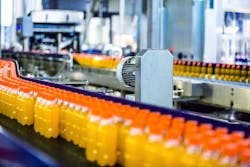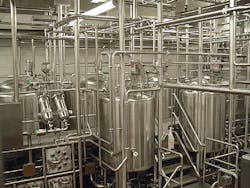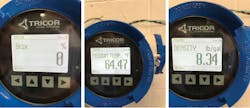Case Study: Processor utilizes Coriolis mass flowmeters
A southeastern U.S. processing company produces a variety of dried natural vegetable flavorings for several national food brands. An important step in the manufacturing process is measuring the Brix or sugar content of the juice concentrate to ensure appropriate amounts are drawn from raw vegetables and not left to waste.
During processing, raw vegetables are washed and then blanched in preparation for grinding to extract juice concentrate. Once removed from the vegetables, the juice is processed through a second wash to remove any carryover — such as dirt, sand, stones, etc. — and then heated to produce a mixture of water and sugar or Brix. Spent grindings derived from the extraction process are dried and supplemented with vitamins and minerals to be made into animal feed, a secondary by-product.
As different raw ingredients become seasonally available, the process changes. For example, celery has a much lower sugar extraction level because of its water content than, for instance, sugar beets. While the mechanics of extraction remain basically the same, the concentration of the “sugars” can vary among different vegetables — from 2% to 20%.
Previously, final product was weighed at the end of the production process, which was several steps after the sugar extraction process. At that point, no corrective actions could be taken to improve process efficiency. To improve yield and ensure greater final product consistency, the processor needed an automated process that monitored Brix during, rather than at the end of, the production cycle.
Challenge
Solution
AW-Lake designed an automated sugar monitoring system consisting of a TRICOR Coriolis Model TCMP Mass Flow Meter and TCD 9100 Transmitter with a display that calculates sugar concentrations during production, providing real-time feedback to operators.
After the grinding process, juice concentrate passes through a TRICOR Coriolis Model TCMP Mass Flow Meter that monitors several process variables including mass flow, sugar content and density. The meter was mounted on the outlet line from the extractor.
The TCMP Mass Flow Meter outputs data to the TCD 9100 Transmitter that uses juice sugar weight in pounds/cubic foot times sugar concentration in percentage to determine produced pounds. The meters help to maintain a consistent percentage of Brix or sugar content derived from different vegetables for a more consistent maximum output and less waste.
A Brix program is saved on tables within the transmitter so operators can easily set up new process parameters to accommodate new vegetables with less complication than when using other mass flowmeters.
Technical advantages
The Coriolis Model TCMP Mass Flow Meter with TCD 9100 Transmitter automates the Brix monitoring process, eliminating the need for manual sampling and weighing the end product as a means of quality control. The process also decreases energy usage by reducing demand on the dryer as higher amounts of solids in process concentrates require less water extraction.
AW-Lake offers a wide selection of flowmeters — Coriolis, gear, turbine, ultrasonic, variable area and paddle wheel — to match the right technology to the applications. AW-Lake’s flow sensors offer numerous outputs: frequency, analog, voltage, Modbus and HART, and the company has transmitters, displays and controllers to complete the system. For more information, go to aw-lake.com.





